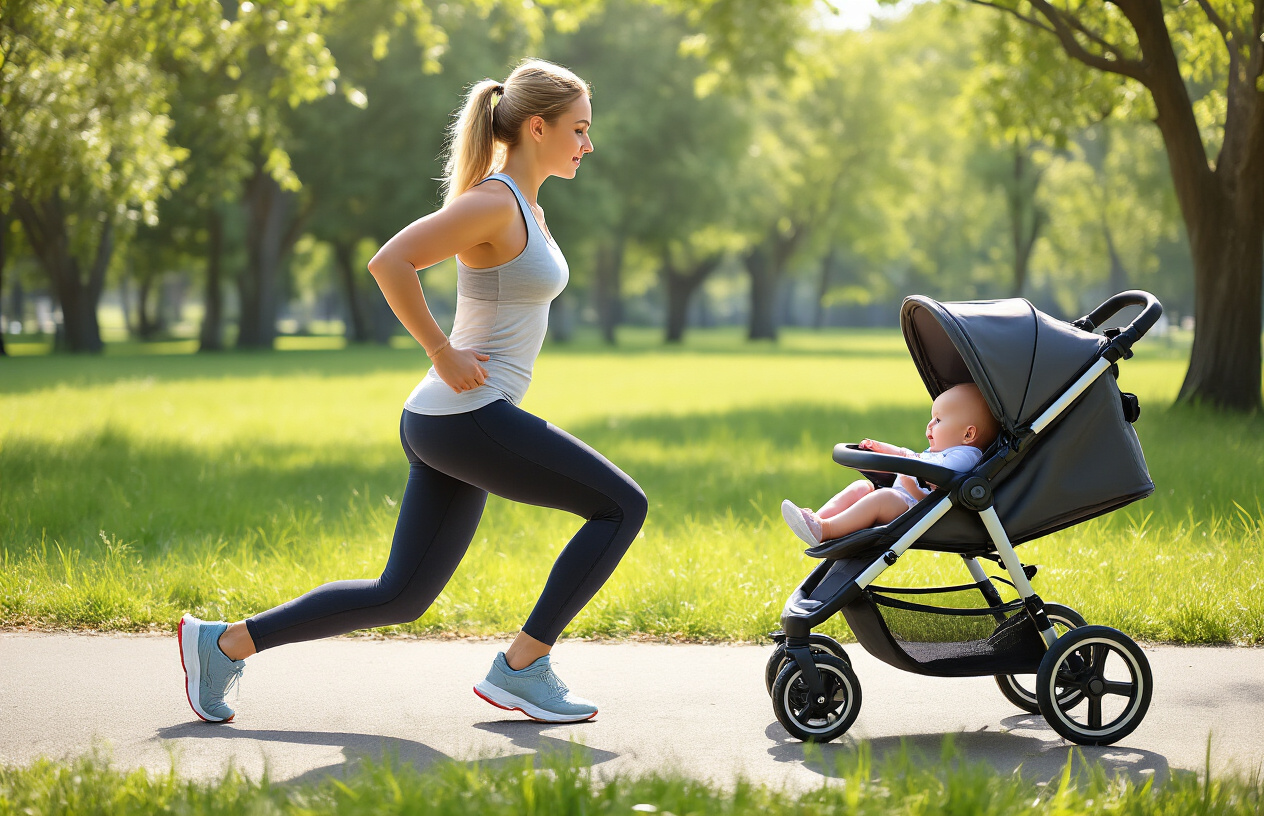Getting back into fitness after having a baby feels overwhelming, especially when you can barely find five minutes to yourself. New moms and caregivers juggling baby care with their own health goals need practical mom-and-baby fitness ideas that work with their unpredictable schedules.
This guide shows you how to stay active while caring for your little one. We’ll cover safe exercises you can do while holding your baby, so you don’t need a babysitter to work out. You’ll also discover stroller-based fitness routines that turn walks into full workouts, plus postpartum recovery exercises tailored to where you are in your healing journey. These strategies help you rebuild strength, boost energy, and bond with your baby through movement.
Safe Exercises You Can Do While Holding Your Baby

Gentle Cardio Moves That Work With Baby’s Weight
Start with marching in place while holding your baby facing outward. This simple movement elevates your heart rate while letting your little one enjoy the view. Add arm swings or gentle side steps to increase intensity. Your baby’s weight naturally adds resistance, making even basic movements more challenging.
Step-touches work wonderfully with babies who love the swaying motion. Hold your baby securely at chest level and step to the right, bringing your left foot to meet it, then repeat on the left side. The rhythmic movement often soothes fussy babies while giving you a solid cardio workout.
Try modified dance moves like gentle hip circles or shoulder rolls. Many babies find the fluid movements calming, and you’ll work your core muscles while keeping your heart rate up. Keep movements smooth and controlled to maintain your baby’s comfort and your own safety.
Core Strengthening Exercises Using Baby as Resistance
Wall sits become incredibly effective when holding your 8-15 pound baby. Lean against a wall with your back flat and slide down until your thighs are parallel to the floor. Your baby adds extra weight that challenges your leg muscles and engages your core for stability.
Modified squats work perfectly with baby weight. Hold your little one close to your chest and perform shallow squats, focusing on proper form rather than depth. The added resistance strengthens your glutes, quadriceps, and core muscles while your baby enjoys the up-and-down motion.
Standing pelvic tilts help rebuild deep abdominal strength. Hold your baby and gently tilt your pelvis forward and backward, engaging your core muscles with each movement. This exercise specifically targets the muscles weakened during pregnancy and childbirth.
Upper Body Workouts That Incorporate Baby Interaction
Baby chest presses turn strength training into playtime. Lie on your back with knees bent, holding your baby securely at chest level. Gently press your baby up and down while maintaining eye contact and making silly faces. This exercise works your chest, shoulders, and triceps while creating precious bonding moments.
Seated baby overhead presses work your shoulders and arms. Sit cross-legged or in a chair, holding your baby at chest level. Slowly press them overhead, engaging your core for stability. Your baby gets an exciting ride while you strengthen your upper body.
Standing baby curls target your biceps effectively. Hold your baby like you would a weight, with arms extended, then curl them up to your chest. Make funny noises or sing songs during the movement to keep your baby entertained and engaged.
Balance and Stability Exercises for New Mom Posture
Single-leg stands while holding your baby challenge your balance and strengthen stabilizing muscles. Start with 10-15 seconds on each leg, gradually increasing duration as your confidence builds. Your baby’s shifting weight makes this exercise more dynamic and effective than traditional balance work.
Heel-to-toe walks improve coordination and posture. Walk in a straight line, placing one foot directly in front of the other while holding your baby. This exercise helps counteract the forward head posture common in new mothers from frequent feeding and carrying positions.
Standing on one foot while gently swaying your baby works your entire kinetic chain. The unpredictable movements required to keep your baby happy challenge your balance in ways static exercises cannot match.
Baby-Friendly Workout Equipment and Setups

Essential gear that accommodates both mom and baby
Resistance bands top the list for new moms because they’re versatile, take up zero space, and won’t wake a sleeping baby. You can anchor them to door frames, stroller handles, or even wrap them around your feet for lower body work while baby sits in your lap. Look for sets with varying resistance levels and comfortable handles.
Yoga mats serve double duty as your workout surface and baby’s tummy time space. Choose thicker mats (at least 6mm) for joint comfort during floor exercises. The extra cushioning helps when you’re doing planks or stretches while baby plays nearby.
Baby carriers designed for exercise change everything. These specially made carriers distribute weight evenly and provide extra support during movement. Unlike regular carriers, fitness versions have breathable mesh panels and secure buckle systems that handle the extra motion from squats, lunges, and walking workouts.
Adjustable dumbbells save money and space compared to full weight sets. Start with lighter weights as your core strength returns, then increase as you progress. Many new moms find 5-15 pound ranges perfect for the first year postpartum.
Exercise balls work for strength training, stretching, and entertaining baby. Your little one will love watching the colorful ball, and you can use it for modified crunches, wall squats, and back stretches. Choose anti-burst versions for safety.
Creating a safe exercise space at home
Clear floor space is your first priority. You need at least 6×6 feet of obstacle-free area where you can move freely without tripping over toys, furniture, or baby gear. Move coffee tables, sharp corners, and breakable items out of reach.
Baby-proofing your workout zone protects curious crawlers. Cover electrical outlets, secure loose cords, and remove small objects that pose choking hazards. Even if baby isn’t mobile yet, planning ahead saves time later.
Good lighting and ventilation make workouts more enjoyable and safer. Open windows or use fans to keep air circulating, especially during intense sessions. Natural light boosts your mood and helps baby maintain healthy sleep patterns.
Storage solutions keep equipment organized and accessible. Wall-mounted racks hold resistance bands and yoga mats, while storage bins corral smaller items like hand weights. The easier it is to grab your gear, the more likely you’ll stick to your routine.
Soft flooring protects both you and baby during floor exercises. Interlocking foam tiles work perfectly – they’re easy to clean, cushion falls, and create defined workout boundaries. Plus, they’re gentler on baby’s knees during crawling practice.
Portable equipment for outdoor workouts with baby
Stroller accessories transform any walk into a full-body workout. Stroller weights add resistance for upper body exercises, while resistance bands attach to handles for strength training during park stops. Cup holder organizers keep water bottles and small weights within easy reach.
Suspension trainers hook onto playground equipment, trees, or even your car for bodyweight workouts anywhere. These lightweight systems pack small but deliver full-body training options. Baby can watch from the stroller while you do rows, squats, and stretches.
Picnic blankets serve as outdoor yoga mats and baby play areas. Choose waterproof versions that won’t absorb moisture from grass. The familiar blanket helps baby feel comfortable in new environments while you exercise.
Portable speakers make outdoor workouts more motivating. Choose wireless, weather-resistant models with good battery life. Upbeat music keeps your energy up and often entertains baby too. Many have clips that attach to strollers or waistbands.
Water bottles with measurement markers help track hydration, especially important when breastfeeding. Insulated versions keep drinks cold during hot weather workouts. Bottles with push-pull caps allow one-handed drinking while pushing strollers.
Collapsible storage keeps outdoor gear organized. Mesh bags hold toys and snacks for baby, while zip compartments separate clean and dirty items. Look for bags with multiple carrying options – backpack straps, stroller clips, and hand handles give maximum flexibility.
Stroller-Based Fitness Routines

Power walking techniques for maximum calorie burn
The key to turning your daily stroller walk into a serious calorie-torching session lies in your posture and pace. Keep your core engaged and shoulders back while maintaining a grip that’s firm but not death-tight on the stroller handle. Your stride should be quick and purposeful – aim for 15-20% faster than your usual leisurely pace.
Push with your whole body, not just your arms. Engage your glutes and hamstrings by taking slightly longer steps and really driving off your back foot. This recruits larger muscle groups and dramatically increases your energy expenditure. Swing your free arm naturally to maintain balance and add momentum.
Target heart rate zones make all the difference. You should be breathing heavily enough that holding a full conversation becomes challenging, but not so hard that you can’t speak in short phrases. This sweet spot typically burns 300-500 calories per hour depending on your weight and terrain.
Choose routes with gentle inclines when possible. Even a 2-3% grade can boost calorie burn by 20-30%. Mix up your terrain between pavement, park paths, and grassy areas to challenge different stabilizing muscles and keep your body guessing.
Stroller strength training exercises at the park
Transform any park visit into a full-body strength session using your stroller as versatile gym equipment. Start with stroller lunges – keep one hand on the handle for balance while stepping back into deep lunges. The stroller’s weight adds resistance while helping you maintain proper form.
Stroller squats work your entire lower body. Position yourself behind the stroller, feet shoulder-width apart, and lower into a squat while pushing the stroller slightly forward. The movement challenges your balance and engages your core more than regular squats.
Use park benches for elevated exercises. Try stroller push-ups by placing your hands on a bench while keeping one hand on the stroller handle, or step-ups while maintaining contact with your stroller for stability.
Tricep dips become more challenging when you incorporate the stroller. Sit on a bench, place hands beside your hips, and extend legs toward the stroller handle for support. This creates an unstable surface that activates more muscle fibers.
Create a circuit by combining 3-4 exercises with 30-45 seconds of work and 15 seconds of rest. Most babies enjoy the gentle rocking motion of strength exercises, making this a win-win activity.
Interval running workouts with stroller safety tips
Jogging strollers open up incredible interval training possibilities, but safety comes first. Always use the wrist strap and keep one hand on the handle at all times. Your baby should be at least 6 months old with good head control before attempting running workouts.
Start with walk-run intervals: 2 minutes easy walking, 30 seconds moderate jogging, repeat 8-10 times. The stroller’s momentum helps carry you through challenging intervals while providing built-in recovery periods during walks.
Hill repeats become incredibly effective with a stroller. Find a gentle 50-100 meter incline and alternate between pushing hard uphill and easy recovery walking downhill. The added resistance builds serious leg strength and cardiovascular fitness.
Check your stroller’s tires before every run – proper inflation prevents wobbling and makes pushing easier. Avoid running on uneven surfaces, and never attempt intervals in crowded areas where sudden stops might be necessary.
Time your intervals around your baby’s temperament. Many babies love the rhythmic motion of interval training, but others prefer steady movement. Start conservatively and adjust based on how both you and baby respond to the workout intensity.
Group stroller fitness classes in your community
Stroller fitness classes create the perfect blend of effective workouts and social connection that new moms desperately need. Most communities offer these classes through recreation centers, mom groups, or specialized fitness instructors who understand postpartum bodies.
Popular formats include Stroller Strides, which combines power walking with bodyweight exercises, and Baby Boot Camp, featuring high-intensity interval training adapted for strollers. These classes typically run 45-60 minutes and accommodate various fitness levels.
The social aspect proves just as valuable as the physical benefits. You’ll meet other parents navigating similar challenges, creating natural playdate opportunities and support networks. Many lifelong friendships start in stroller fitness classes.
Look for instructors with postpartum exercise certifications who understand diastasis recti, joint instability, and other common post-pregnancy concerns. They’ll offer modifications and ensure you’re exercising safely during recovery.
Cost varies widely – some community centers offer classes for $5-10, while specialized programs might charge $15-25 per session. Many offer package deals or monthly memberships that make regular attendance more affordable. Don’t forget to check if your insurance offers fitness reimbursements for postpartum exercise programs.
Postpartum Recovery Exercises by Timeline

First 6 Weeks: Gentle Movement and Breathing Exercises
Your body has just accomplished something incredible, and right now it needs patience and gentle care. During these first six weeks, your focus should be on healing and reconnecting with your core muscles.
Deep Breathing and Pelvic Floor Activation
Start with diaphragmatic breathing while lying down or sitting comfortably. Place one hand on your chest and one on your belly. Breathe slowly, allowing your belly to rise while keeping your chest relatively still. As you exhale, gently engage your pelvic floor muscles – imagine drawing them up and in like a gentle lift.
Gentle Walking
Short 5-10 minute walks around your neighborhood or even just around your house can work wonders. Listen to your body and stop if you feel any pressure or discomfort. Walking helps improve circulation and can boost your mood while being gentle on your healing body.
Basic Core Connection Exercises
Try gentle heel slides while lying on your back. Slowly slide one heel away from your body along the floor, then back. This helps reawaken your deep core muscles without straining your healing abdominal muscles.
Neck and Shoulder Releases
Feeding and holding your baby can create serious tension. Simple neck rolls and shoulder blade squeezes can provide immediate relief. Sit or stand tall, roll your shoulders back, and squeeze your shoulder blades together for 5 seconds.
6-12 Weeks: Progressive Strength Building Routines
Once you’ve been cleared by your healthcare provider (usually around 6-8 weeks), you can start building back your strength systematically.
Modified Planks and Wall Push-ups
Start with wall push-ups, standing arm’s length from a wall. Place your palms flat against the wall and slowly push away and back. Graduate to incline push-ups using a couch or sturdy chair before attempting knee or full planks.
Functional Squats and Lunges
These movements mirror activities you’ll do daily – picking up toys, getting up from the floor, carrying your growing child. Start with bodyweight squats, focusing on proper form. Hold onto a chair for balance if needed.
Core Rehabilitation Sequence
Begin with dead bugs: lying on your back, extend opposite arm and leg while maintaining a neutral spine. Progress to bird dogs on hands and knees, and eventually to modified side planks.
Resistance Band Workouts
Resistance bands are perfect for this phase – they’re gentle on joints while providing variable resistance. Try banded rows for your upper back, lateral walks for your glutes, and chest presses to counteract the forward posture from feeding and carrying baby.
3+ Months: Advanced Fitness Challenges for Active Moms
By three months postpartum, many women feel ready to challenge themselves again. Your energy levels may be more stable, and your body has had time to adapt to its new normal.
High-Intensity Interval Training (HIIT)
Short bursts of intense exercise followed by rest periods can be incredibly effective when time is limited. Try 20 seconds of mountain climbers, rest for 40 seconds, then move to jump squats or burpees. Start with 10-15 minute sessions.
Full-Body Compound Movements
Exercises that work multiple muscle groups simultaneously give you the biggest bang for your buck. Think squat-to-press combinations, deadlift variations, and Turkish get-ups (which actually mimic getting up from the floor with a baby).
Progressive Running Programs
If running was part of your pre-pregnancy routine, you can gradually return to it. Start with walk-run intervals and pay close attention to any pelvic pressure or incontinence. A good sports bra is absolutely essential – invest in proper support.
Strength Training with Weights
You can now incorporate dumbbells, kettlebells, or barbells back into your routine. Focus on exercises that support your daily mom activities: overhead presses for lifting babies, rows for carrying car seats, and squats for playing on the floor.
Remember that every recovery journey looks different, and comparing yourself to others won’t serve you well. Some days you’ll feel strong and ready to tackle a challenging workout, other days gentle movement is exactly what your body needs.
Making Exercise Time Work With Baby’s Schedule

Quick 10-minute workouts during nap times
Naptime presents the perfect window for focused exercise without distractions. These short bursts can be surprisingly effective when you maximize every minute.
High-Intensity Circuit Options:
- 2 minutes jumping jacks or high knees
- 2 minutes bodyweight squats
- 2 minutes push-ups (modified as needed)
- 2 minutes mountain climbers
- 2 minutes planks or core work
Strength-Focused Sessions:
- Target one muscle group per session
- Alternate between upper body, lower body, and core days
- Use compound movements like burpees, thrusters, or deadlifts
- Keep rest periods minimal to maximize time efficiency
The key is having everything ready before baby goes down. Lay out your mat, set a timer, and keep water nearby. No equipment changes or complicated setups – just pure movement.
Early morning routines before baby wakes up
Morning workouts offer the most predictable exercise time, though they require strategic planning around your baby’s sleep patterns.
Optimal Timing Strategies:
- Wake 30-45 minutes before baby’s usual wake time
- Start with 15-20 minute sessions until you build the habit
- Keep workouts quiet to avoid early wake-ups
- Have everything prepared the night before
Quiet Morning Workout Ideas:
- Yoga flows or stretching sequences
- Bodyweight strength training
- Pilates routines
- Silent cardio like step-ups or modified jumping jacks
Energy Management Tips:
- Go to bed 30 minutes earlier to compensate
- Keep a simple pre-workout snack ready
- Start with lighter workouts and gradually increase intensity
- Listen to your body – some mornings call for gentle movement
Morning exercise sets a positive tone for the entire day and creates a reliable routine that becomes easier to maintain over time.
Evening wind-down exercises that help baby sleep
Evening workouts can double as a calming bedtime routine for both you and your baby. The right activities create a peaceful transition into night.
Baby-Inclusive Wind-Down Activities:
- Gentle yoga with baby lying nearby
- Slow walking or marching in place while holding baby
- Stretching routines with soft music
- Breathing exercises that baby can hear and find soothing
Post-Bedtime Options:
- Restorative yoga sequences
- Light stretching to release daily tension
- Meditation or mindfulness practices
- Gentle strength training with controlled movements
Creating the Right Environment:
- Dim lighting to support natural melatonin production
- Soft background music or nature sounds
- Comfortable temperature settings
- Avoid high-intensity workouts that spike adrenaline
Evening exercise helps process the day’s stress while preparing your body for better sleep quality. This timing works especially well for parents who feel too tired for morning workouts.
Flexible workout plans for unpredictable baby days
Babies thrive on routine, but they’re also masters of surprise. Having adaptable exercise options prevents missed workout days from derailing your fitness goals.
Modular Workout Approach:
Create exercise “building blocks” that can be combined or shortened:
- 5-minute warm-up sequences
- 10-minute strength circuits
- 5-minute cardio bursts
- 10-minute cool-down stretches
Backup Plan Strategies:
- Plan A: 30-minute dedicated workout
- Plan B: 15-minute quick session
- Plan C: 5-minute movement breaks throughout the day
- Plan D: Active recovery like walking or gentle stretching
Baby-Mood Adaptations:
- Fussy days: Incorporate baby-wearing exercises or stroller walks
- Clingy phases: Floor exercises where baby can see and touch you
- Sleep regression periods: Focus on stress-reducing activities like yoga
- Growth spurts: Gentle movement that accommodates extra feeding times
Weekly Planning Template:
| Day | Primary Plan | Backup Option | Baby-Inclusive Alternative |
|---|---|---|---|
| Monday | 20-min strength | 10-min circuit | Baby-wearing walk |
| Tuesday | 30-min cardio | 15-min HIIT | Stroller workout |
| Wednesday | Yoga flow | Stretching | Floor play exercises |
Keep a “movement menu” accessible on your phone with options for different time windows and energy levels. Remember that consistency beats perfection – even five minutes of movement counts as a win.
Fun Movement Activities That Entertain Your Baby

Dance Workouts That Make Baby Giggle
Turn on your favorite upbeat playlist and get ready for the most entertaining workout of your life. Babies absolutely love bouncing and swaying movements, making dance workouts perfect for both mom’s fitness and baby’s entertainment. Start with gentle bounce squats while holding your little one facing outward – the rhythmic motion combined with music often triggers delighted giggles.
Try incorporating shoulder rolls and arm circles while doing side steps or marching in place. Your baby will be fascinated by your movements and may even try to mimic them. High-low movements work exceptionally well – reach your arms up high, then squat down low while keeping baby secure. The visual stimulation keeps them engaged while you work your legs and core.
Salsa-style hip movements combined with light calf raises create an effective lower body workout. Keep one hand supporting baby while the other moves freely to the beat. Latin music works particularly well because of its consistent rhythm and cheerful tempo.
For core engagement, try gentle twisting motions while holding baby at chest level. The rotation activates your obliques while the changing visual perspective entertains your little one. Remember to maintain proper posture – imagine a string pulling you up from the crown of your head.
Dance workouts can last anywhere from 10 to 30 minutes, depending on your energy level and baby’s mood. Pay attention to your baby’s cues – overstimulation can lead to fussiness, so take breaks when needed.
Yoga Poses That Incorporate Baby as Your Partner
Partner yoga takes on new meaning when your partner weighs less than 20 pounds and coos adorably during downward dog. Modified yoga poses with baby create bonding opportunities while helping you rebuild strength and flexibility after pregnancy.
Start with baby-wearing variations of standing poses. Tree pose becomes more challenging and engaging when baby’s weight shifts your center of gravity. Use a yoga block or wall for support initially, and enjoy how baby’s movements add an element of balance training you never expected.
Seated spinal twists work beautifully with baby sitting on your lap facing outward. The gentle rotation helps release tension in your back while baby enjoys the new perspective of the room. Keep movements slow and controlled – sudden motions might startle your little one.
Modified cobra pose can include baby lying on a blanket in front of you. As you lift your chest, you’re creating eye contact and interaction with your baby, making the pose more enjoyable for both of you. This variation also helps counteract the forward head posture common in new moms from frequent feeding and carrying.
Baby bridge pose involves your little one sitting securely on your hips while you perform the bridge. Their weight adds resistance while their giggles provide motivation. Always ensure baby can sit independently before attempting this variation.
Cat-cow stretches can be done with baby crawling underneath you (if they’re mobile) or lying on their back below you for peek-a-boo interactions. The gentle spinal movements feel amazing for postpartum backs while creating playful moments with baby.
Playground Exercises While Baby Plays Nearby
The playground offers a perfect outdoor gym where you can exercise while keeping baby entertained and socialized. This setting provides fresh air, varied terrain, and equipment that doubles as workout gear.
Use playground benches for step-ups, tricep dips, and incline push-ups while baby sits in a stroller or plays in the sandbox nearby. The bench height creates the perfect angle for strengthening your arms and chest. For step-ups, focus on controlled movements up and down, engaging your glutes and thighs.
Swing sets aren’t just for kids – the support structure works excellently for modified pull-ups or resistance stretches using resistance bands. While baby swings gently (if age-appropriate) or watches from their stroller, you can perform upper body exercises using the swing set frame.
Walking lunges around the playground perimeter combine cardio with strength training. The varied terrain of grass, mulch, and pavement challenges your stability muscles differently than indoor surfaces. Take breaks to push baby on age-appropriate equipment or engage with them in the sandbox.
Playground hills or slopes provide natural incline training. Walking or jogging up gentle hills while pushing a stroller adds intensity to your cardio workout. The resistance builds leg strength while the outdoor environment provides mental health benefits.
Monkey bars can be modified for hanging exercises that help rebuild grip strength and decompress your spine after months of carrying baby. Even if you can’t traverse the entire length, hanging for short periods helps counteract rounded shoulders and tight chest muscles common in new mothers.

Staying active with a baby doesn’t have to feel impossible. From simple exercises while holding your little one to creative stroller workouts, there are plenty of ways to get moving that work around your new routine. The key is starting with gentle postpartum recovery exercises and gradually building up as your body heals and your confidence grows.
The best part about these fitness approaches is that they can actually become bonding time with your baby. Dancing, stretching, or taking brisk walks can be just as entertaining for them as they are beneficial for you. Remember to listen to your body, work with your baby’s natural schedule instead of against it, and celebrate small wins. Every bit of movement counts, and finding what works for your family is more important than following any perfect fitness plan.














